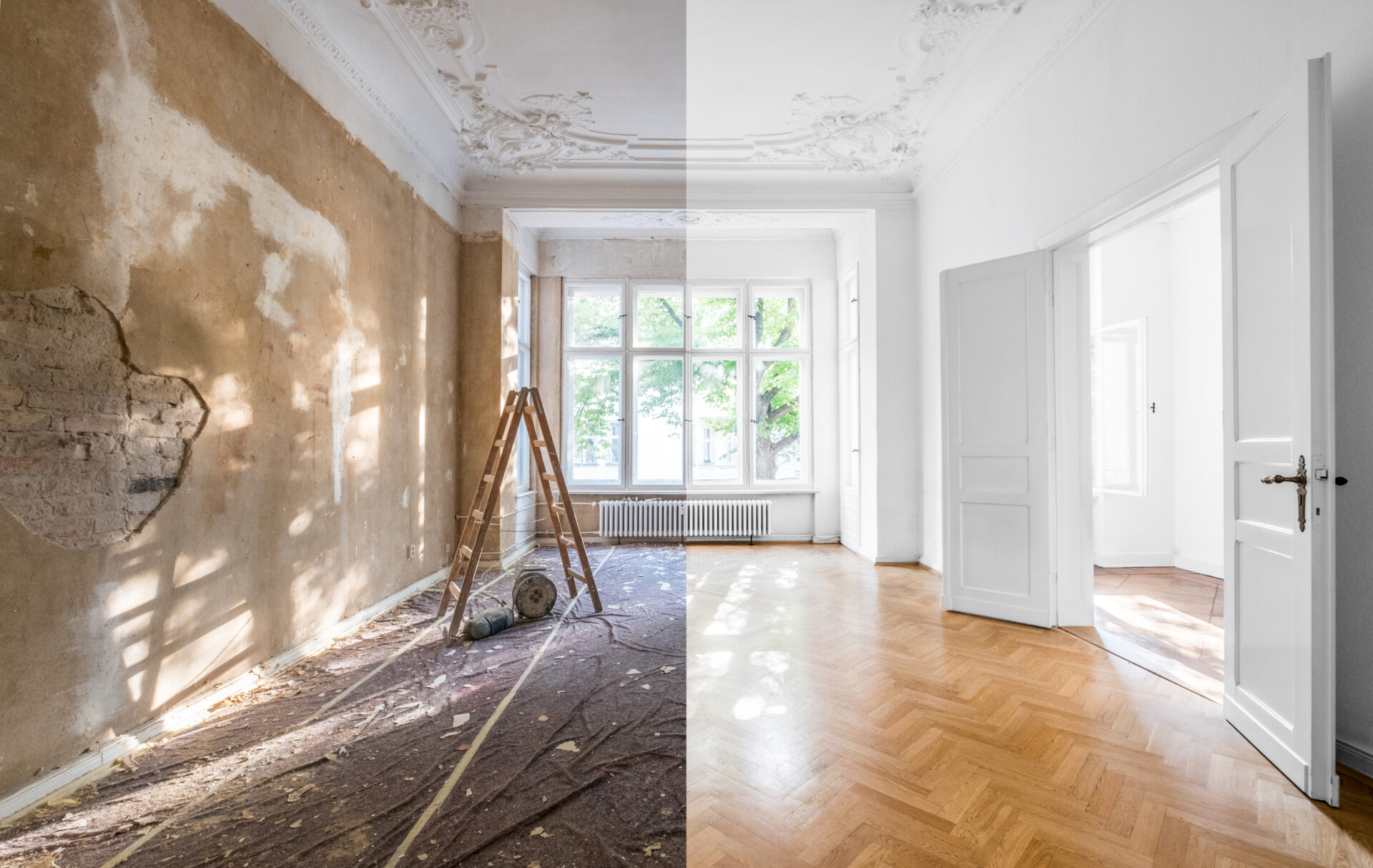Undertaking a refurbishment or conversion? The best way to finance these kinds of projects is with a refurbishment bridging loan (or ‘refurb loan’). Here’s how they work.
How Refurbishment Bridging Loans Work
Like ordinary bridging loans, refurb loans allow you to buy a property (in this case, the property you want to refurbish or convert). But they also include a works facility, which you can use to cover your build costs.
Your lender will release the portion of the loan that’s going towards your property acquisition on Day 1 (the day you complete on your purchase). Then you’ll be able to draw down tranches of your works facility each month, in arrears.
At the end of each month, your lender will send a monitoring surveyor to assess the work you’ve done. If the surveyor is satisfied you’re on track, they’ll sign off on the next drawdown of funds, which you can use to cover costs you’ve accrued.

Before your Day 1 loan is released and you can complete on your property purchase, your project will need to go through your lender’s due diligence process. This usually involves valuation and QS reports being written to assess your GDV and build cost estimates, respectively.
If the GDV comes in lower than expected or the build costs come in higher, you may have to renegotiate terms with your lender. You’ll need to pay for the valuation and QS reports (as well as the lender’s legal fees) up front, so make sure you have some capital available at the outset.
Refurbishment bridging loans are usually secured against the property with a first charge. If you’re unable to pay the loan back, for whatever reason, your lender will step in and take possession of the property.
Types of Refurbishment Bridging Loan
There are two types of refurb loan: light refurbishment and heavy refurbishment.
Light refurbishments typically involve cosmetic improvements. For example, these might include:
- fresh paint
- flooring updates
- electrical rewiring
These projects aim to make a property more attractive and comfortable without making significant structural changes.
Heavy refurbishments do involve structural changes and usually require more time and money. They might include:
- the removal and building of walls
- extensions
- the redesign of a property’s existing layout
These two types of refurbishment bridging loan come with differing interest rates and leverage, reflecting the fact that heavy refurbishments carry more risk for lenders than light ones.
Refurbishment Bridging Loan Amounts, Rates and Leverage
Refurbishment bridging loans usually cover 100% of the cost of works. But like ordinary bridging loans, they only cover a certain percentage of the property’s purchase price. This is to protect lenders who take security against the property and want to guard against falls in its value.
At the top end of the market, lenders will lend up to 75% loan-to-value (gross) for a light refurbishment. This drops to 70% loan-to-value for heavy refurbs, reflecting the increased risk that comes with more extensive works.
Whether your project is light or heavy, you’ll need to find funds to cover the balance of the purchase price left by your refurb loan. This equity – whether your own or an investor’s – will also need to cover acquisition costs including stamp duty, your legal fees, and any agents’ fees that may be applicable.

Interest rates for refurbishment bridging loans vary depending on the lender and project. However, they generally range from 5% to 8% p.a., plus the Bank of England Base Rate. Interest is usually rolled up into the gross loan and paid at the end of the project, when you either sell your refurbished property or refinance onto a buy-to-let mortgage.
Refurb loan amounts also vary from lender to lender but tend to range from £100k (for small, light refurbs) through to £20m+ for large-scale, heavy refurbs or conversions.
Why undertake a refurbishment?
Refurb and conversion projects offer advantages that ground-up development schemes lack. Here are a few reasons why you might want to undertake one.
Shorter timelines
Refurb projects often take less time to complete than ground-up ones. This is because the time-consuming structural features of the building (such as the foundation, frame, and supporting walls) are already in place.
A small ground-up project might require an eighteen-month loan term (twelve months for build, plus a six-month sales period). But a small refurb project may only require twelve months (nine months for the works, plus a three-month sales period).
As you’ll accrue less interest over a shorter loan term, you’ll benefit from lower finance costs. A shorter timeline also allows you to take equity and profit out of your project faster.
Reduced need for planning permission
Another advantage is that refurbishment and conversion projects don’t always need full planning permission. For example, light refurbs don’t require planning approval at all.
In other instances, you may be able to secure approval without submitting a full planning application. Many commercial buildings, such as offices, can be converted to residential flats under permitted development rights. You’ll need to apply for approval from the relevant local authority but your project is unlikely to be refused, if you conform to certain criteria.
If you’re converting a property (from an HMO into a large single-family home, for example), you may be able to submit a change of use application. Such applications usually take less time to be approved or rejected than full planning applications and tend to have a higher success rate.
Heavy refurbs sometimes require planning permission (if they involve adding significant extensions, for example). But generally speaking, refurbs and conversions allow you to avoid the costly, time-consuming and uncertain planning process that is so often necessary to ground-up projects.
Building a track record
Refurbishment projects are useful to early-career developers who are trying to build a track record.
A track record is essential to successfully applying for development finance. Without evidence that you’ve previously completed ground-up projects on time and on budget, most lenders will consider you too risky a prospect, regardless of how profitable your project might be.
But you can often apply for refurbishment bridging loans with relatively little experience. If you have an industry background and are starting small – with a light refurb, for example – you have a reasonably good chance of a lender backing you, if your project is profitable enough.
By using refurbs to build a track record, you can give lenders confidence that you can deliver and move on to small ground-up projects.
Where to get a refurbishment bridging loan
One way of getting a refurbishment bridging loan is to perform some market research on the products available and apply directly to lenders. Lots of lenders that offer ordinary bridging loans and development finance also offer refurb loans. Find out what leverage, interest rates and loan amounts these lenders are offering, then apply to your chosen lender through their website.
Another way of getting a refurb loan is to go through a broker. Development finance brokers have a broad knowledge of the market and what’s available at any given time. A good broker will analyse your project, match you with an appropriate lender, and negotiate the best possible terms. They will then submit an application on your behalf and liaise between you and the lender to ensure that any obstacles to completion are overcome.
Whether you apply directly to a lender or go through a broker, you will need to provide information about yourself and your project to secure indicative terms on a refurbishment bridging loan. This might include the following:
- a CV
- a summary of your recent developments
- a project appraisal
- sales comparables
You will also need to provide an assets and liabilities statement to show that you can give a personal guarantee in the event of things going wrong with the project. This is usually equivalent to 20-25% of the gross loan amount.
—
Enjoy this blog? Click here to join our mailing list and have future blogs delivered straight to your inbox.


